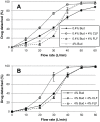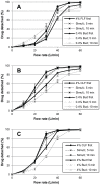New mechanisms to explain the effects of added lactose fines on the dispersion performance of adhesive mixtures for inhalation
- PMID: 24489969
- PMCID: PMC3905031
- DOI: 10.1371/journal.pone.0087825
New mechanisms to explain the effects of added lactose fines on the dispersion performance of adhesive mixtures for inhalation
Abstract
Fine excipient particles or 'fines' have been shown to improve the dispersion performance of carrier-based formulations for dry powder inhalation. Mechanistic formulation studies have focussed mainly on explaining this positive effect. Previous studies have shown that higher drug contents may cause a decrease in dispersion performance, and there is no reason why this should not be true for fines with a similar shape, size and cohesiveness as drug particles. Therefore, the effects on drug detachment of 'fine lactose fines' (FLF, X50 = 1.95 µm) with a similar size and shape as micronised budesonide were studied and compared to those of 'coarse lactose fines' (CLF, X50 = 3.94 µm). Furthermore, interactions with the inhalation flow rate, the drug content and the mixing order were taken into account. The observed effects of FLF are comparable to drug content effects in that the detached drug fraction was decreased at low drug content and low flow rates but increased at higher flow rates. At high drug content the effects of added FLF were negligible. In contrast, CLF resulted in higher detached drug fractions at all flow rates and drug contents. The results from this study suggest that the effects of fines may be explained by two new mechanisms in addition to those previously proposed. Firstly, fines below a certain size may increase the effectiveness of press-on forces or cause the formation of strongly coherent fine particle networks on the carrier surface containing the drug particles. Secondly, when coarse enough, fines may prevent the formation of, or disrupt such fine particle networks, possibly through a lowering of their tensile strength. It is recommended that future mechanistic studies are based on the recognition that added fines may have any effect on dispersion performance, which is determined by the formulation and dispersion conditions.
Conflict of interest statement
Figures





References
-
- Arnold K, Grass P, Knecht A, Roos R, Sluke G, et al. (1995) Powders for inhalation. A61K 9/14 ed.
-
- Jones MD, Price R (2006) The influence of fine excipient particles on the performance of carrier-based dry powder inhalation formulations. Pharmaceutical Research 23: 1665–1674. - PubMed
-
- de Boer AH, Chan HK, Price R (2012) A critical view on lactose-based drug formulation and device studies for dry powder inhalation: Which are relevant and what interactions to expect? Advanced Drug Delivery Reviews 64: 257–274. - PubMed
-
- Jones MD, Santo JGF, Yakub B, Dennison M, Master H, et al. (2010) The relationship between drug concentration, mixing time, blending order and ternary dry powder inhalation performance. International Journal of Pharmaceutics 391: 137–147. - PubMed
-
- Thalberg K, Berg E, Fransson M (2012) Modeling dispersion of dry powders for inhalation. The concepts of total fines, cohesive energy and interaction parameters. International Journal of Pharmaceutics 427: 224–233. - PubMed
Publication types
MeSH terms
Substances
LinkOut - more resources
Full Text Sources
Other Literature Sources

